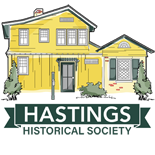
by Natalie Barry
Several months ago, our new mayor Niki Armacost was asked to speak to the 3rd/4th and 5th graders at Hillside and Farragut Middle School, respectively. During the Q&A segment, one child asked whether our village has an official animal. That got Mayor Armacost thinking about the eagle on the Hastings-on-Hudson village seal. She posed the question to the Historical Society: Why do we have an eagle on the seal? And what do the stars, arrows and leaves mean?
At the cottage, we started digging around and came up with some insights. While we may not have answered every one of Mayor Armacost’s questions, we think you might be interested in what we discovered. This is almost verbatim what our response was to Mayor Armacost’s inquiry.
The U.S. Great Seal
Eagles have been used on American seals since the early days of our Republic and many municipalities use aspects of the national seal in their insignia. The bald eagle was chosen on June 20, 1782 as the emblem of the United States of America, because of its long life, great strength and majestic looks, and also because it was then believed to exist only on this continent. The Great Seal of the United States (shown below) was also introduced publicly in 1782; it appeared on the reverse side of the one-dollar bill in 1935. In the U.S. Great Seal, the eagle’s wings are outstretched (or displayed). S/he is facing left, towards the olives branches in its talon on that side, symbolizing a preference for peace. There are 13 arrows, representing the 13 original states, in its other talon. Above its head is a “glory,” again with 13 stars.

We’re not sure when the village of HoH started using a seal with an eagle. The earliest eagle in public view we could find is displayed at the top of the World War I memorial at the foot of Fulton Park, shown below:

The Society enlisted the help of Village Clerk Joe Cerretani, whose office has a number of seals in their possession. Clerk Cerretani looked through binders of old Village Board meetings from 1879 to 1904, also 1926 through 1929. None had any seals on them. It’s possible that the village adopted an eagle seal early on, although we couldn’t find any use of it before 1929.
Official Hastings-on-Hudson Village Seal
According to Clerk Cerretani, the “official” village seal, which is on file at the New York Department of State, looks like the image below. This particular image was in the Society’s files, on the cover of a November 18, 1929 program inaugurating the Municipal Building.

The Village Clerk’s office has a heavy cast iron press, which imprints this same official seal on documents. This press looks like it is decades old, possibly from the 1930s or earlier. Its imprint is the same as what is shown above. In terms of what the leaves and arrows mean, we have no specific information on that. The leaves could be olive branches, like the ones on the U.S. seal, although they could be referring to another type of foliage. The significance of the three arrows is unclear (the three hills in Hastings? a reference to the village, town and county? these are just guesses). In this earlier version of the seal, there are no stars above the eagle’s head.
Menconi’s Eagle
Keep in mind that 1929 was when the Municipal Building was constructed and dedicated. Hastings resident and famous sculptor Raffaele Menconi created a majestic bronze eagle, which was placed on top of the building, seen below circa 1940:

Sometime in the 1940s, the eagle was removed from the roof and placed into storage. Over the years, the eagle statue became buried in sand in the basement of the Municipal Building and was only uncovered when the police firing range was enlarged in 1979. The statue was placed on a new pedestal in 1979, to commemorate the centennial of our village’s incorporation, and now resides outside on the right portico of the Municipal Building. Here is the sculpture in a recent photo:

So it’s possible that we had a seal prior to 1929 and the eagle statue was created independently — or it may be that the statue and our village seal were both inaugurated in 1929, when our Municipal Building was dedicated. Note, however, that the eagles are facing different directions in our official seal and Menconi’s statue.
Modern Village Seal
A newer, more modern version of the village seal features prominently on the first floor entrance hall area of the Municipal Building. In this updated version, the eagle’s head is now facing right and s/he is all black. Three stars have appeared over the eagle’s head. The arrows and leaves have also changed sides, which is intriguing. The eagle’s head is still turned to the side holding the leaves, which would be in keeping with the foliage being olive branches. The photo below shows the seal on the hall floor:

According to records donated to the Historical Society by architect Peter Gisolfi, this new seal was placed into the hallway during the 1999 renovation of the Municipal Building. According to discussions with several officials who held village positions during that time, then-Village Manager Neil Hess and his associate Raf Zaratzian were in favor of updating the village seal and took the opportunity to do so when the building was being remodeled. Various versions of this new seal currently appear on village letterhead, envelopes, business cards, and on this seal that sits at the front counter of the Village Clerk’s office, shown below. (Note that this paperweight seal does not have three triangles between the “V” of Village and the “N” of Hudson, which appear in the seal on the floor.)

In these various (new) versions being used today, sometimes the eagle’s head is black and sometimes it is white, but it is always facing right. The wings differ a bit in the various newer versions. In Clerk Cerretani’s opinion, some of this variation may simply come down to what eagle images the printer who is replicating the stationary has on hand.










Thank you so much for the article on the Village seal! It’s interesting how it has changed so little over the years. I’m so glad the eagle from the original Municipal building was rediscoved and is now on display for all to see.